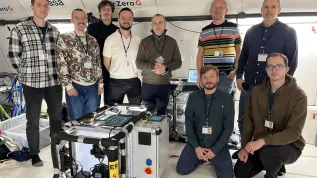
The Solar Orbiter probe was the first instrument in history to conduct observations of the poles of our daytime star. This will help us better understand the Sun’s magnetic field, its activity cycles, and space weather. Experts from the Space Research Centre of the Polish Academy of Sciences (CBK PAN) participated in the construction of the probe.
All the planets of the Solar System, as well as the probes traversing this system, follow orbits on one plane called the ecliptic. The exception is the European-American probe Solar Orbiter, whose orbit is intentionally tilted to this plane, so that it is possible to observe the solar poles.
At the time of the video recording sent by the probe, Solar Orbiter was observing the Sun at an angle of 17 degrees, which enabled the capture of the star's south pole.
'For the first time in history, we see the solar south pole at an angle of 17 degrees, much greater than we can see from Earth. This means less foreshortening, a better view of the pole and more information that we have been waiting for for a whole generation', comments Tomasz Mrozek, PhD, a heliophysicist from the Solar Physics Team of the Space Research Centre PAS in Wrocław, who worked on the mission.
He believes that this is still just the beginning. 'In the coming years, gravitational assists of Venus will take Solar Orbiter even higher above the ecliptic and we will see the poles at an angle greater than 30 degrees. Observations of the poles will primarily allow us to (literally) remove black spots from models of the Sun. Until now, we had to assume the conditions in these places, without fully knowing what the areas around the poles actually look like. Thanks to the new data, the quality of the models of the 11-year activity of the Sun will improve significantly, and our understanding of solar magnetism will become more complete', Mrozek adds.
The European Space Agency (ESA) Director of Science, Prof. Carole Mundell, quoted in the press release, points out: 'The Sun is our nearest star, giver of life and potential disruptor of modern space and ground power systems, so it is imperative that we understand how it works and learn to predict its behaviour. These new unique views from our Solar Orbiter mission are the beginning of a new era of solar science'.
The collection of images sent by the probe shows the Sun's south pole, captured on March 16-17 this year. At that time, the probe observed the star at an angle of 15 degrees below the solar equator. This was the first observation from such a large angle, carried out just a few days before it reached its current maximum of 17 degrees.
The images were taken using three of the probe's scientific instruments: the Polarimetric and Helioseismic Imager (PHI), the Extreme Ultraviolet Imager (EUI) and the Spectral Imaging of the Coronal Environment (SPICE).
PHI images the Sun in visible light and maps its surface magnetic field. EUI shows the Sun in ultraviolet light, revealing the charged gas at millions of degrees in the Sun's corona. SPICE, on the other hand, records light emitted by charged gas at different temperatures above the Sun's surface, revealing different layers of its atmosphere.
By combining observations from the three instruments, scientists can learn how material moves around the Sun's outer layers. This could reveal unexpected features such as polar vortices - swirling masses of gas similar to those seen around the poles of Venus and Saturn.
These groundbreaking observations also have implications for understanding the Sun's magnetic field and why it reverses every 11 years or so, coinciding with the star's peak activity. Current models and predictions of the solar cycle still cannot accurately predict when and with what intensity the Sun will reach its peak activity.
One of the first scientific discoveries based on the new observations is that the Sun's magnetic field is currently chaotic near its south pole.
While a normal magnet has a clearly defined north and south pole, PHI's magnetic field measurements show that the Sun's south pole has both north and south magnetic fields at the same time.
This phenomenon occurs only for a short time each solar cycle - during the solar maximum, when the Sun's magnetic field reverses. After this reversal, one polarity should become dominant, eventually taking over the Sun's poles.
In the meantime, in about 5 to 6 years, the Sun will reach its next solar minimum - a period when its magnetic field is most orderly and its activity is lowest.
'How exactly this build-up occurs is still not fully understood, so Solar Orbiter has reached high latitudes at just the right time to follow the whole process from its unique and advantageous perspective', says Professor Sami Solanki, one of the mission scientists.
The strongest magnetic fields are found in two bands either side of the Sun's equator, the scientists explain. The dark red and dark blue regions highlight active regions, where magnetic field gets concentrated in sunspots on the Sun’s surface (photosphere).
Meanwhile, both the Sun's south and north poles are speckled with red and blue patches, demonstrating that at small scales, the Sun’s magnetic field has a complex and ever-changing structure.
At the same time, the SPICE instrument precisely measured the speeds at which the clumps of solar material were moving. The resulting velocity map reveals how solar material moves within a specific layer of the Sun.
It is also crucial that Doppler measurements can reveal how particles are flung out from the Sun in the form of solar wind. Uncovering how the Sun produces solar wind is one of Solar Orbiter's key scientific goals.
These are just the first observations made by Solar Orbiter from its newly inclined orbit. The complete dataset of Solar Orbiter's first full 'pole-to-pole' flight past the Sun is expected to arrive on Earth by October 2025. All ten of Solar Orbiter’s scientific instruments will collect unprecedented data in the years to come.
Experts from the Space Research Centre of the Polish Academy of Sciences who contributed to the creation of the probe participated in research and engineering work on the STIX (X-ray Spectrometer/Telescope). This instrument is responsible for observing accelerated electrons - it determines the time and source of their emission, its intensity and spectral characteristics. Data obtained with STIX help explain the mechanism of electron acceleration on the Sun and how they are transported into interplanetary space.
Experts from the Space Research Centre PAS took part in developing the data processing unit for this instrument (including electronics and some software), developed a housing for the data processing unit and for the power supply unit provided by the Czech group, and performed thermal modelling of the STIX instrument and its subsystems.
Marek Matacz (PAP)
mat/ bar/













